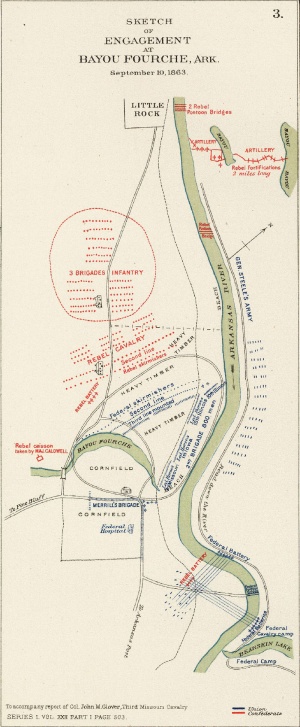John Sappington Marmaduke
John Sappington Marmaduke (1833-1887) was an officer for the Confederate States of America during the American Civil War, and a commander in several battles of the Little Rock Campaign.
Contents
Early Life and Education
Marmaduke was born on March 14, 1833, on a plantation near Arrow Rock, Missouri. His father, Meredith Miles Marmaduke, was the eighth governor of Missouri. His great-grandfather, John Breathitt, was a governor of Kentucky. Marmaduke attended Chapel Hill Academy and Masonic College in Missouri, then spent two years at Yale University and an additional year at Harvard University. He was appointed to the U.S. Military Academy at this point, graduating in 1857.
Civil War in Arkansas
Marmaduke resigned from the U.S. Army in April 1861. The Confederate War Department ordered him to Arkansas, where he became lieutenant-colonel for the 1st Arkansas Battalion, serving under Lt. General William J. Hardee. After fighting in the Battle of Shiloh, he was promoted to brigadier general.
The Battle of Brownsville took place on August 25, 1863. The battle took place about seven weeks after the Union victory at the Battle of Helena. The march on Brownsville began around July 31 when U.S. Major-General Ulysses S. Grant ordered Federal troops to begin moving towards Clarendon and then DeValls Bluff. Troop movements began under Union Brigadier-General John W. Davidson. Davidson had 6,000 cavalrymen and sixteen artillery pieces. At Brownsville 1,300 Confederate cavalrymen under the command of Brigadier-General Marmaduke guarded the approach to Little Rock. The two forces met on the morning of August 25th. The Confederates fell back about six miles during the battle.
The Battle of Reed's Bridge took place two days later on August 27th. Marmaduke and Brigadier-General Lucius M. Walker shared command of the Confederate cavalry, which was under orders to slow the Union advance. The Confederates destroyed the bridge to prevented the Federals from crossing of the Bayou Meto. Two days later Union forces forded the stream five miles to the south. Marmaduke accused Walker of cowardice during the battle. Walker challenged Marmaduke to a duel and was killed on September 6th.
The Battle of Bayou Fourche again pitted Marmaduke against Davidson. Confederate cavalrymen under Marmaduke's command met Davidson at Fourche Bayou east of the city (site of the present Port of Little Rock on September 10th. Davidson's troops crossed the Arkansas River to the Fourche Creek bayou and, with the help of an artillery barrage, drove the Confederates back into the city. Little Rock was captured by federal troops later on the evening of September 10th.
Marmaduke was also present for the Battle of Boonville, Battle of Prairie Grove, Battle of Springfield II, Battle of Hartville, Battle of Cape Girardeau, Red River Campaign, Price's Raid, and Battle of Mine Creek.
Postbellum Career
Marmaduke returned to his native Missouri after the war. He served as governor of the State of Missouri from 1885 to 1887. He died on December 28, 1887. He is buried at Arlington National Cemetery.
